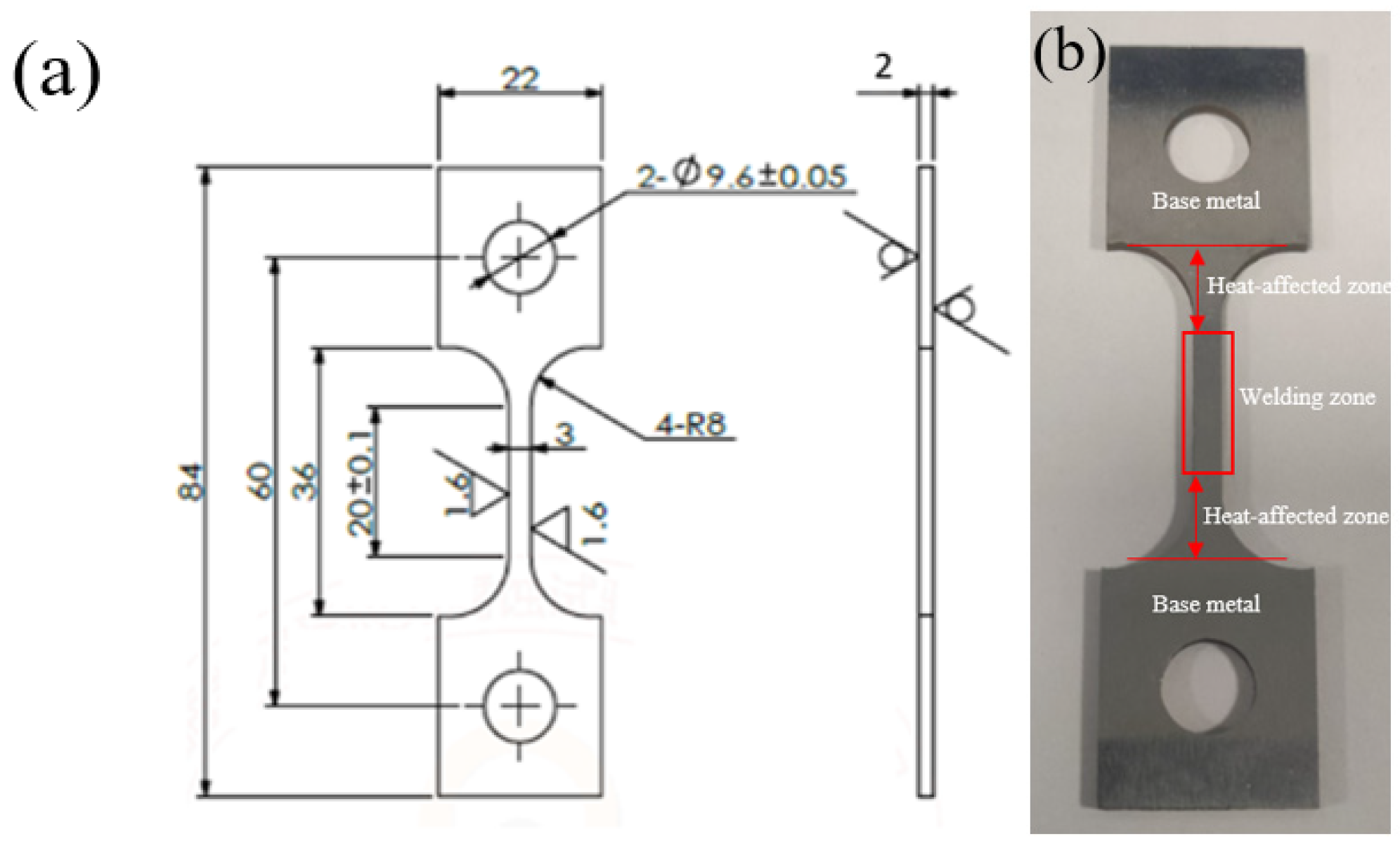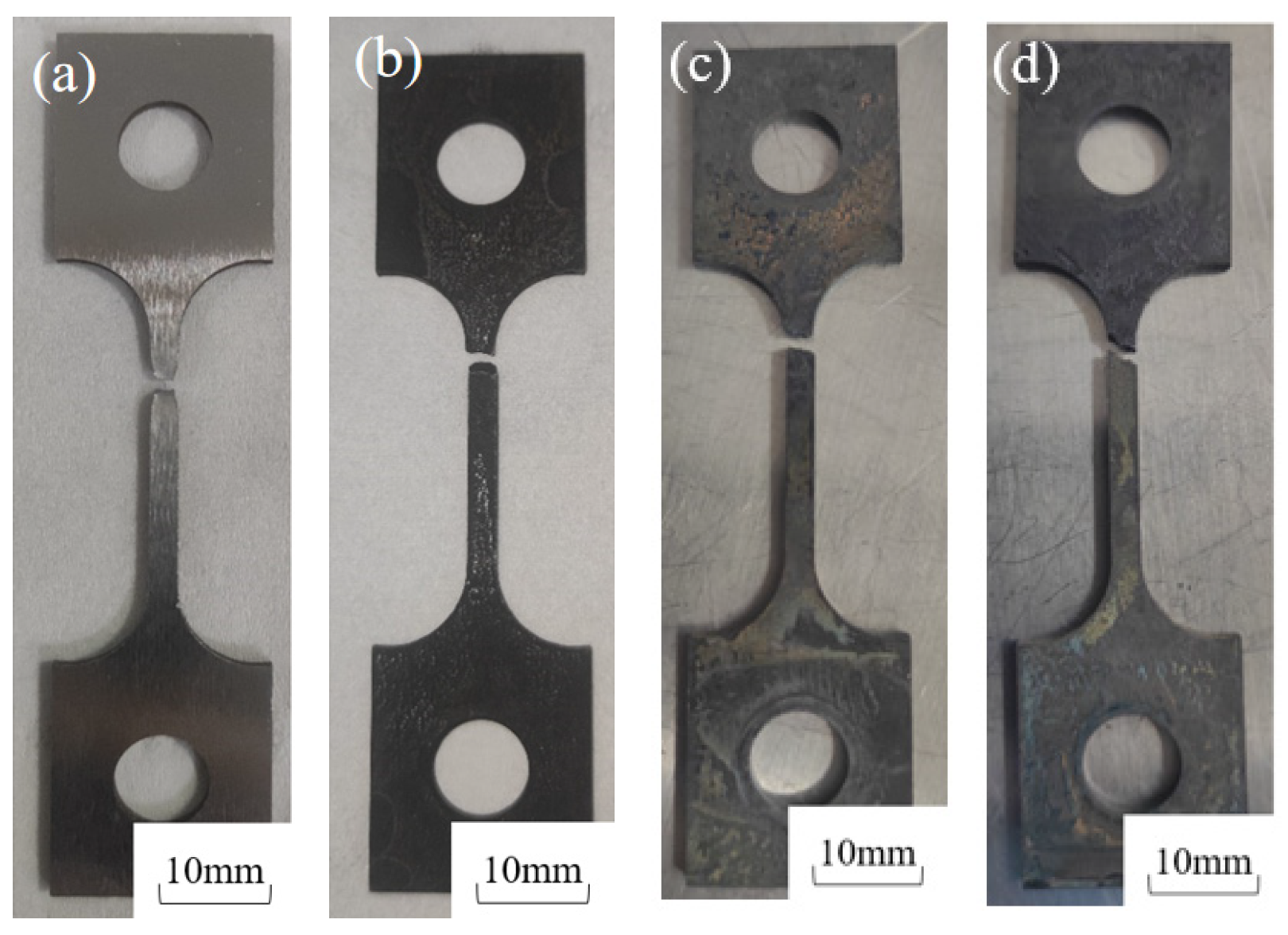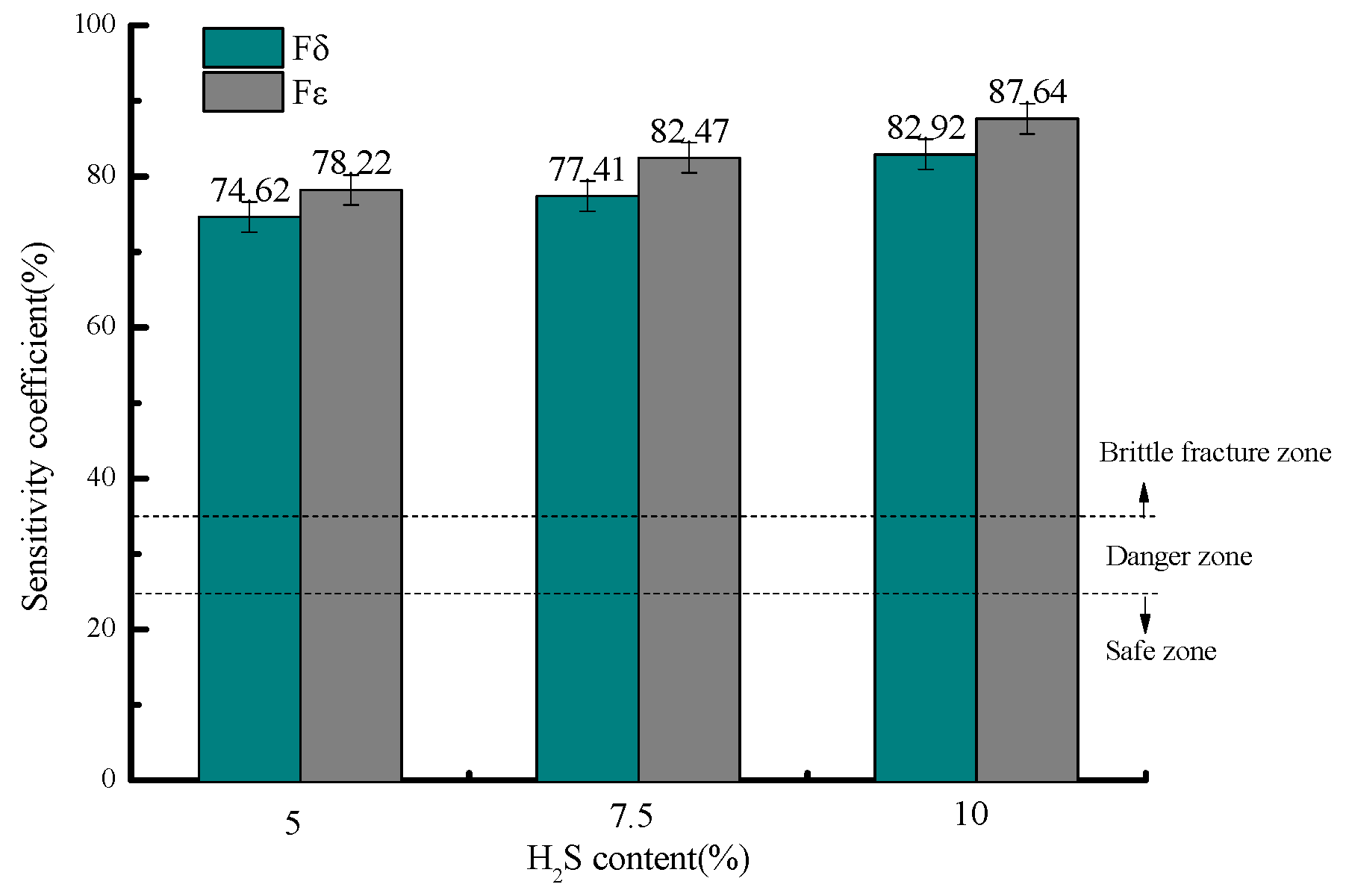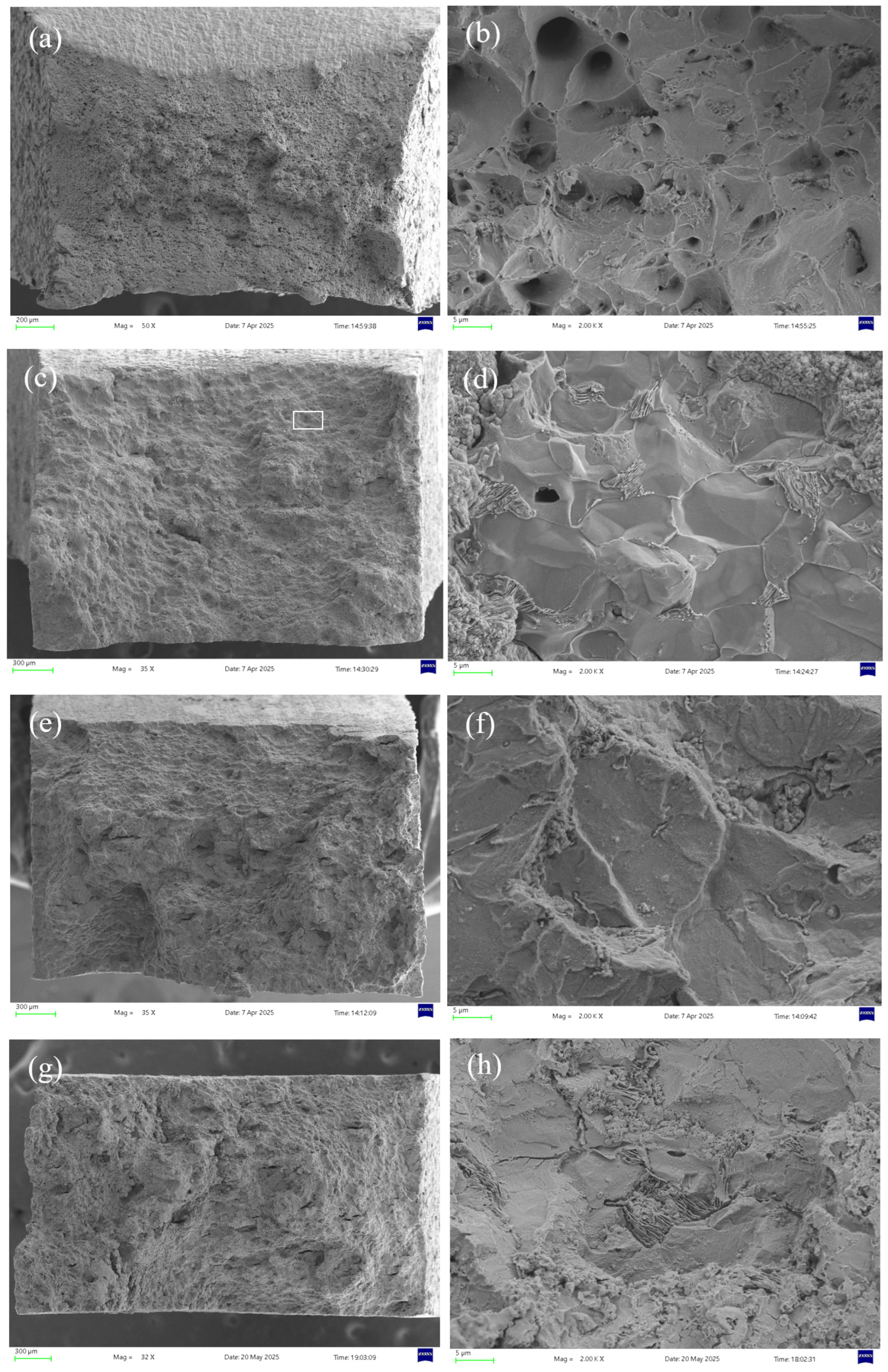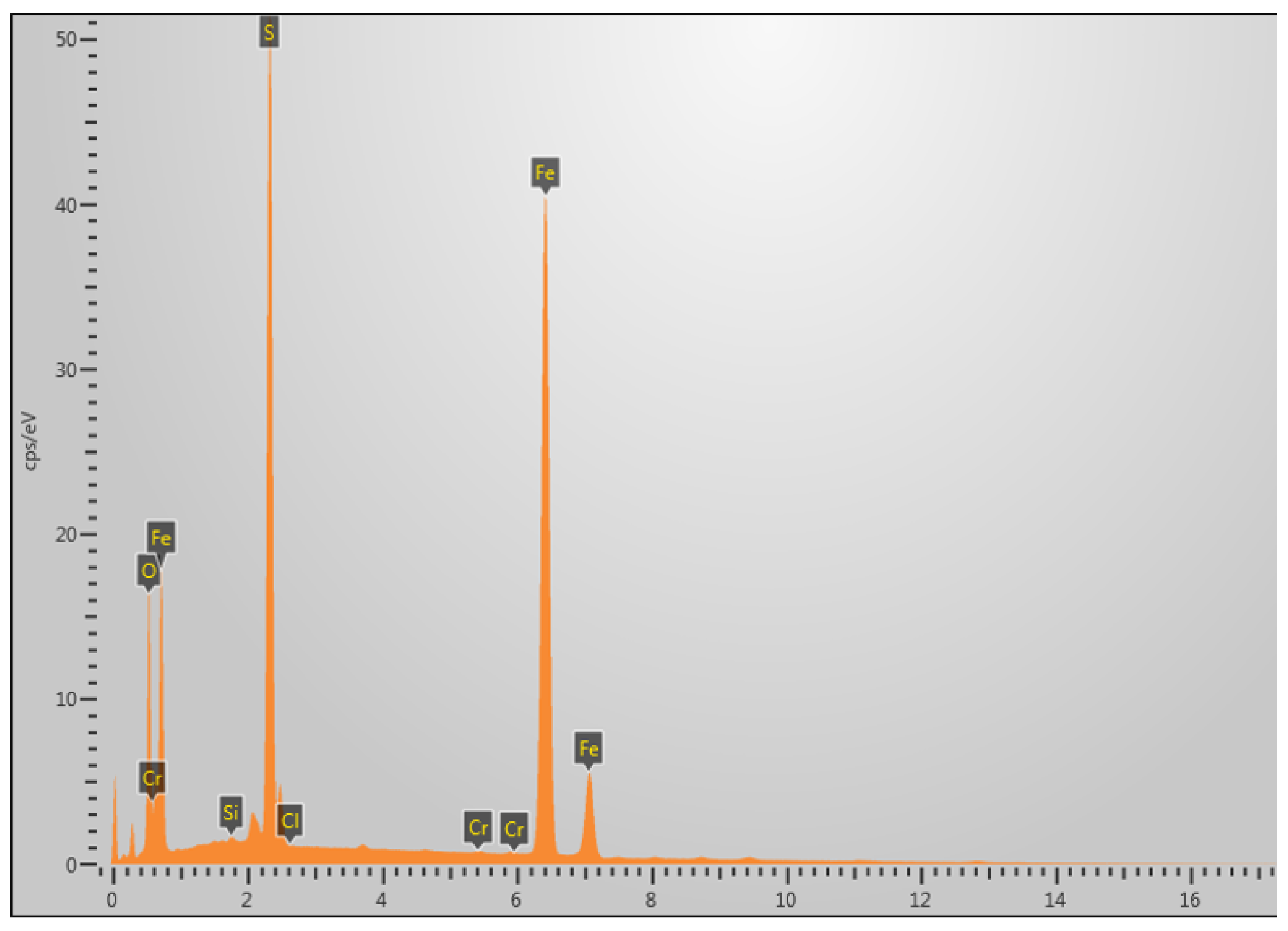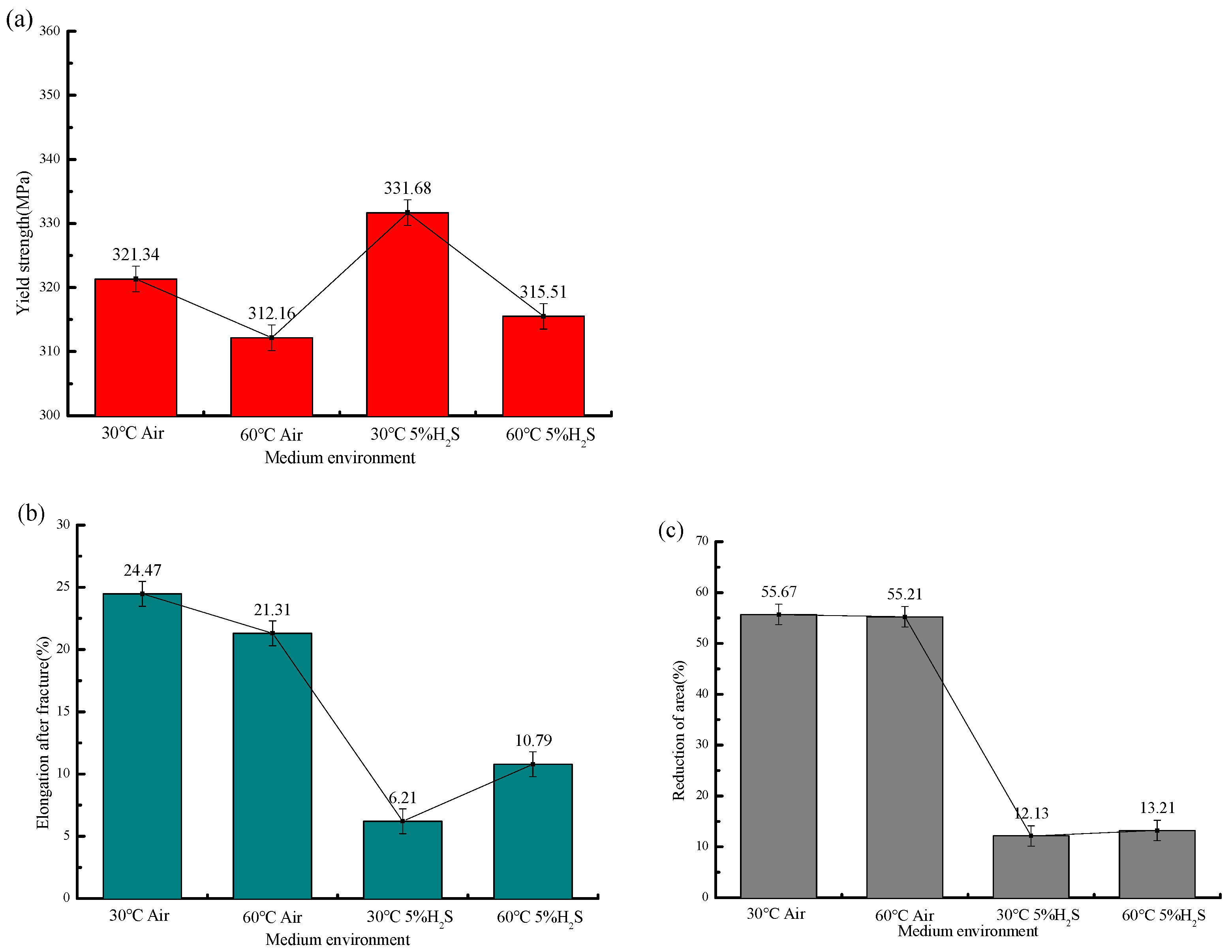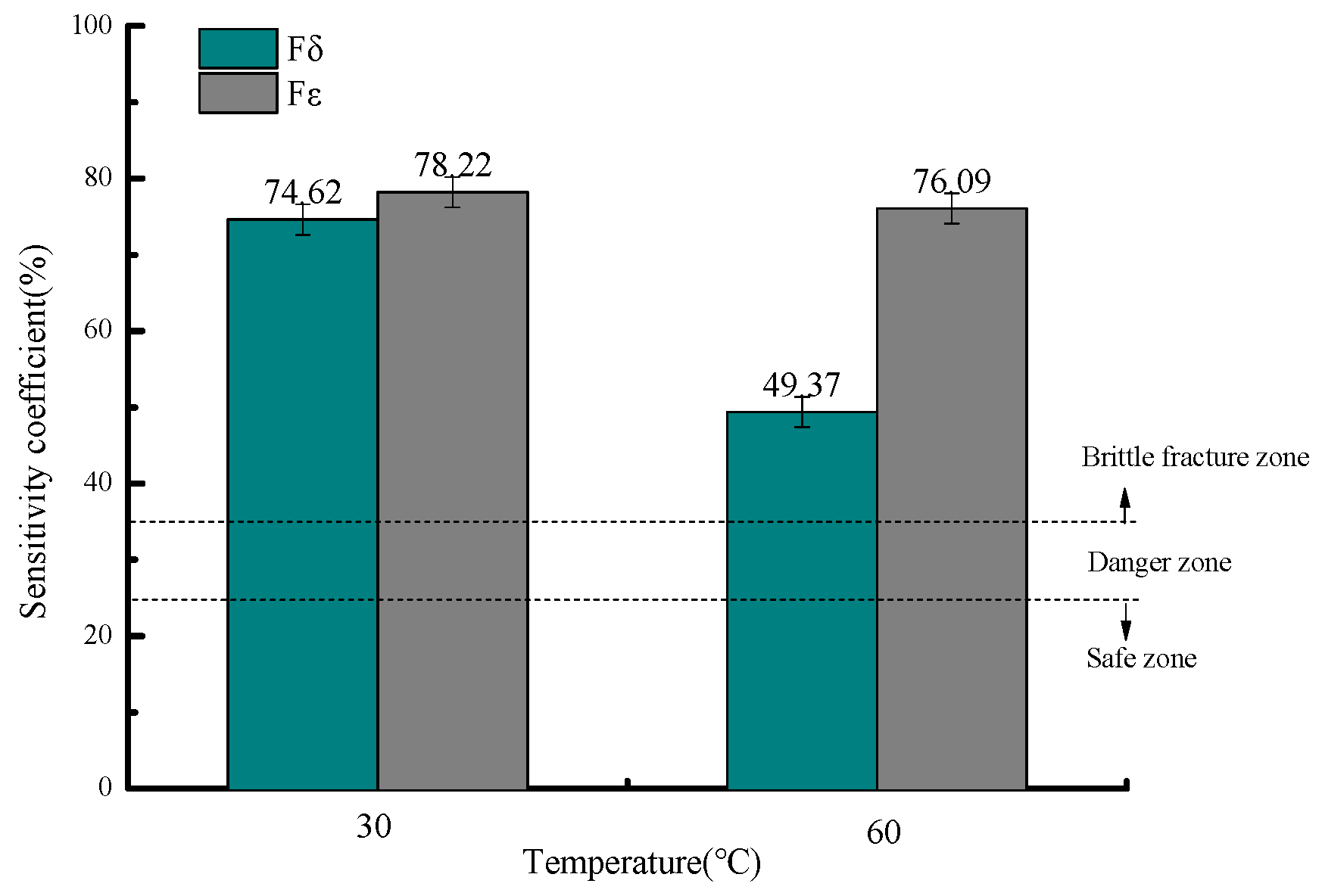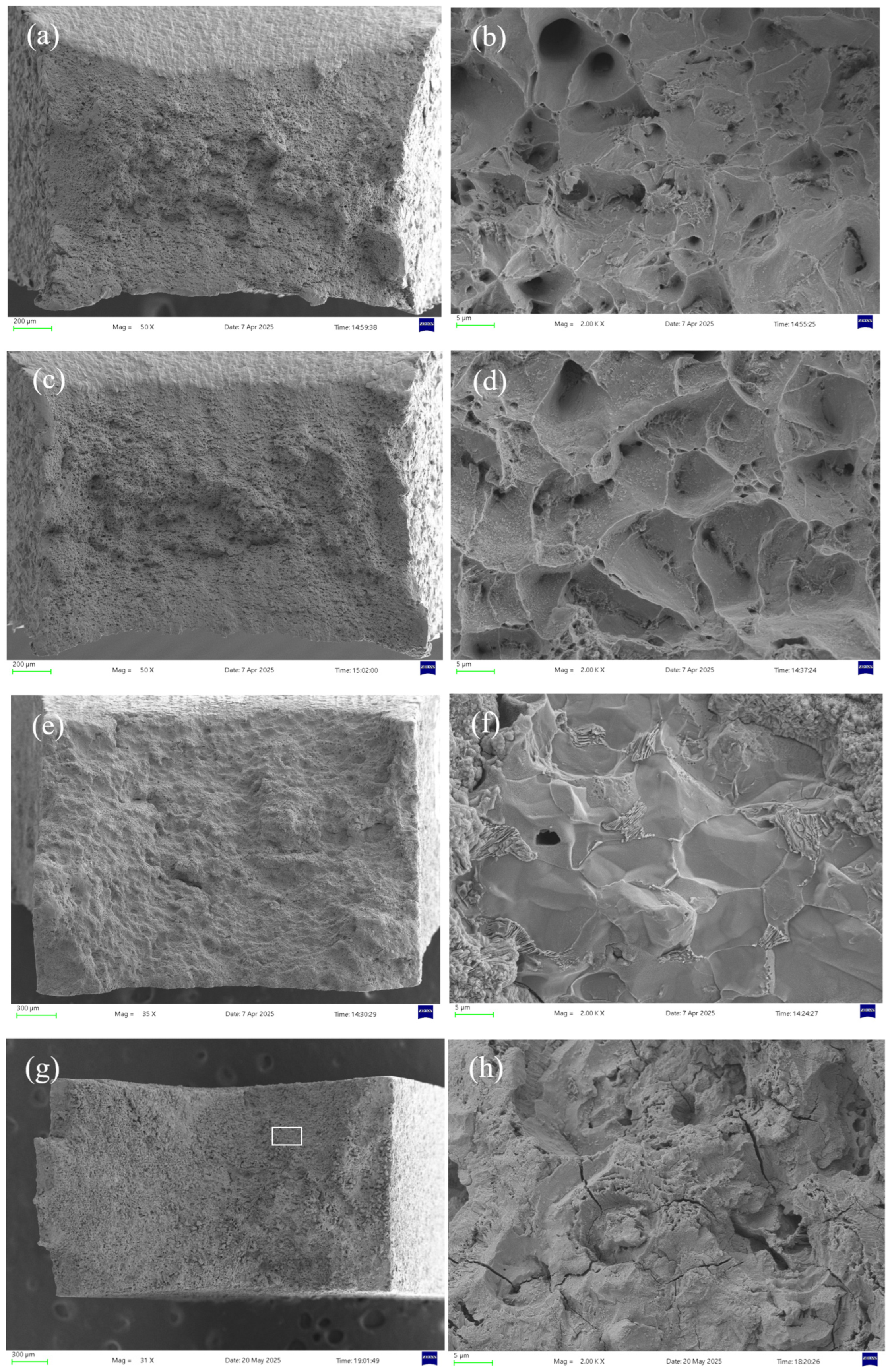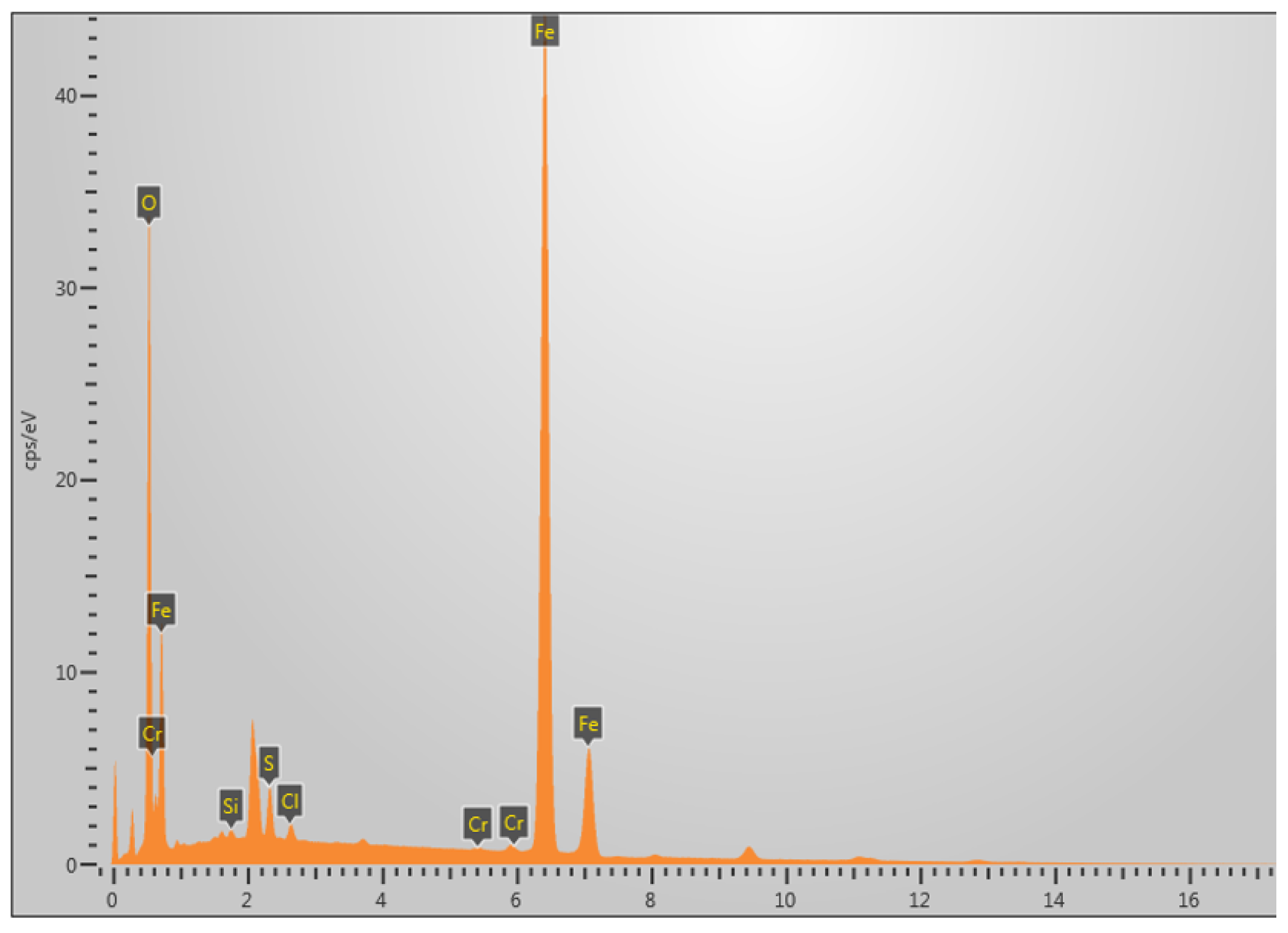1. Introduction
In the development of oil and gas fields, H
2S and CO
2, as associated gases produced during petroleum extraction, cause severe corrosion issues in pipeline materials. In high-sulfur oil and gas fields, the risk of sulfide stress corrosion cracking (SSCC) in pipelines is particularly prominent, with the primary corrosion types being uniform corrosion and stress corrosion cracking (SCC) [
1,
2,
3]. Among these, stress corrosion cracking predominantly occurs in the girth weld zones, characterized by concealment and suddenness. The time to failure can range from a few hours to several years, often without obvious early warning signs. Conventional inspection methods struggle to detect microcracks in their initial stages. However, once cracks initiate, they can lead to sudden and catastrophic failure within a short period, posing extremely high risks [
4,
5].
In recent years, certain progress has been made in the study of stress corrosion behavior in pipeline steels. Xu et al. [
6] found that the mechanical properties of corroded steel deteriorate with increasing corrosion severity, leading to ductility degradation. Liu et al. [
7] observed that as the hydrogen sulfide (H
2S) concentration rises, the stress corrosion susceptibility of steel increases while its corrosion-resistant lifespan decreases. Abdullah [
8] analyzed the stress–strain curves of corroded steel through tensile tests and noted that while yield strength and ultimate tensile strength remained largely unchanged, elongation significantly decreased. Zhou et al. [
9] investigated hydrogen diffusion behavior in low-carbon tubing steel under varying H
2S partial pressures, concluding that H
2S partial pressure alters the composition and structure of corrosion product films, thereby affecting hydrogen diffusion. Ikeda et al. [
10] demonstrated that in CO
2 environments with H
2S partial pressures exceeding 0.003 MPa, steel is highly prone to sulfide stress corrosion cracking (SSCC). These findings indicate that H
2S partial pressure significantly influences the corrosion behavior of metallic materials in high-pressure environments.
In wet H
2S environments, the degradation of steel begins with electrochemical corrosion. Dissolved H
2S facilitates the penetration of hydrogen atoms (H
+) into the steel. Some of these hydrogen atoms accumulate at internal defects (such as inclusions and microcracks) and combine to form hydrogen molecules, creating significant internal pressure that leads to hydrogen blistering (HB). When these blisters connect to form step-shaped cracks, hydrogen-induced cracking (HIC) occurs, a process that requires no external stress. Simultaneously, hydrogen dissolved in the crystal lattice embrittles the steel. If tensile stress (external or residual) is present, sulfide stress corrosion cracking (SSCC) may initiate, often occurring in high-hardness areas such as near welds [
11,
12].
Stress corrosion cracking (SCC) results from the combined effects of stress and corrosive media, with its critical threshold dependent on material properties, environmental conditions, and applied stress. However, existing research on corrosion behavior lacks quantitative studies on the stress corrosion susceptibility of materials in H2S environments. The understanding of stress corrosion cracking sensitivity in environments with hydrogen sulfide content greater than 5% is not clear enough.
20# steel has a better balance of strength, plasticity, and weldability compared to other carbon steel materials. The proportion of ferrite and pearlite in 20# steel is relatively moderate [
13]. This study focuses on aged 20# steel pipelines with girth welds that have been in service for nearly 30 years, examining their mechanical properties and stress corrosion behavior under varying H
2S concentrations and temperatures in H
2S/CO
2 environments. This article quantitatively analyzes the effects of hydrogen sulfide content and temperature on material stress corrosion sensitivity in environments with hydrogen sulfide content greater than 5%.
4. Discussion and Analysis
The results of this study indicate that the H
2S content and temperature have a significant impact on the sensitivity of SSCC in 20# steel welds, which is rooted in their regulatory effects on the dominant mechanism and process of stress corrosion cracking. Based on the observed phenomenon in this experiment—that is, as the concentration of H
2S increases, the elongation at break and the reduction in cross-sectional area of the material decrease, and the brittleness characteristics intensify (as stated in the first point of
Section 5)—it can be inferred that the stress corrosion cracking mechanism dominated by hydrogen embrittlement is the dominant mechanism leading to the deterioration in the performance of the 20# steel weld under the high-sulfur conditions simulated in this experiment.
The stress corrosion cracking process dominated by hydrogen embrittlement in H
2S environment is shown in Equation (3).
The HS
− and S
2− that are dissociated after H
2S dissolves in water will adsorb on the metal surface, strongly hindering the recombination of hydrogen atoms into H
2 molecules and promoting the diffusion of hydrogen atoms into the steel interior [
31]. The results of this study show that when the concentration of H
2S increased from 0 to 5%, the elongation at break sharply decreased by 74% (stated in the first point of
Section 5). This cliff-like decline confirms that the initial introduction of H
2S greatly accelerated the hydrogen evolution reaction, producing a large number of hydrogen atoms and infiltrating into the metal. Due to the embrittlement effect of hydrogen, the bonding force between metal atoms was reduced, resulting in a sharp loss of material toughness and a significant increase in stress corrosion sensitivity.
A finding worth further discussion is that the effect of H
2S concentration is not linear. This experiment clearly reveals that 0–5% is the sensitive critical range of the material, and after exceeding 5%, the toughness degradation effect (elongation at break only decreased by 2.11%) and sensitivity improvement (increased by 12%) caused by the further increase of H
2S concentration to 10% are significantly slowed down (stated in the third point of
Section 5). This phenomenon can be explained by the “surface adsorption saturation” and “corrosion product film effect”. In the low concentration range (0–5%), the surface active sites of the material are sufficient, and the hydrogen adsorption and permeation rates increase almost linearly with the H
2S concentration, leading to a sharp manifestation of hydrogen damage effects. When the concentration exceeds the critical value, the hydrogen adsorption on the material surface gradually becomes saturated, and the hydrogen permeation rate reaches a stable plateau. Therefore, further increases in H
2S concentration weaken the “gain” effect of hydrogen embrittlement.
In addition, as pointed out in references [
32], dense sulfide corrosion product films such as FeS are more likely to form in high H
2S concentration environments. This study also observed the coverage of corrosion product films in SEM microstructure analysis. This film, to some extent, hinders the direct contact between the corrosive medium and the substrate, partially offsetting the accelerated corrosion tendency caused by high H
2S concentration. The coupling of these two effects, namely, hydrogen adsorption saturation and the physical barrier effect of corrosion product film, jointly leads to a decrease in the sensitivity of materials to changes in H
2S concentration in high-sulfur (H
2S > 5%) environments. This discovery has important guiding significance for engineering practice: once the concentration of H
2S in the environment exceeds the critical value, simply pursuing further reduction in the H
2S concentration will have a low marginal benefit in improving the material’s resistance to SSCC performance, and other factors such as temperature, stress concentration, and material quality should be paid more attention to.
The effect of temperature shows a different pattern from that of H
2S concentration. The results of this study show that increasing the temperature from 30 °C to 60 °C can reduce the stress corrosion sensitivity of the material by nearly 30% (as stated in the second point of
Section 5), indicating that the low-temperature environment significantly exacerbates the risk of SSCC. This is mainly due to two factors: solubility and reaction kinetics. On the one hand, an increase in temperature will accelerate chemical reactions and hydrogen diffusion rates, theoretically exacerbating hydrogen-induced cracking. On the other hand, the solubility of H
2S gas in aqueous solution decreases with increasing temperature [
33]. In this study, the negative effect of solubility dominated. The increase in temperature leads to a decrease in the number of H
2S molecules actually involved in the corrosion reaction in the solution, weakening the “source power” of the hydrogen evolution reaction and reducing the amount of hydrogen permeation, thereby reducing the sensitivity to hydrogen embrittlement.
Corrosion product film formation mechanism: The increase in temperature affects the morphology and protective properties of corrosion products. As stated in
Section 5, at higher temperatures (60 °C), there is a greater tendency to generate dense FeS or FeS
2 films with better protective properties [
34], which can effectively block the invasion and corrosion of hydrogen; at a low temperature of 30 °C, loose and unprotected products such as Fe
9S
8 may be generated, providing channels for hydrogen permeation. The phenomenon observed in this study, where the cross-sectional shrinkage rate increases with increasing temperature (as stated in the second point of
Section 5), supports the assertion that the protective film plays a positive role.
In summary, the experimental results of this study clearly indicate that for the 20# steel weld, the H2S concentration is the “initiating” factor that triggers cracking, especially below the critical concentration where its impact is most severe; And temperature mainly exerts its “inhibitory” or “promoting” effect by adjusting the corrosiveness of the medium and the characteristics of the product film, with a smaller impact than the H2S content.
This conclusion has important broader implications: The importance of material quality control: Given that 20# steel is in a sensitive area in a sulfur-containing environment, it is crucial to strictly control the quality of welds and base materials (such as chemical composition, microstructure, and avoiding hard martensitic structures) and eliminate stress concentration points (through optimized design and post-weld heat treatment). These internal factors are often the triggers for hydrogen-induced cracking. Priority of environmental parameter control: In the design and management of operating conditions, keeping the H2S concentration below 5% brings the greatest safety benefits. For environments that are already above 5%, more attention should be paid to temperature monitoring and insulation to avoid equipment operating at low temperatures, which is more operationally and economically viable than further desulfurization.
The stress corrosion cracking of metal materials in a wet H
2S environment is commonly referred to as sulfide stress corrosion. Compared to other media environments, materials in H
2S environments suffer from more severe stress corrosion failure due to hydrogen embrittlement [
35]. This is because HS
- and S
2- in H
2S environments hinder the recombination of hydrogen atoms adsorbed on metal surfaces into hydrogen gas, leading to an increasing concentration of hydrogen atoms on the surface and promoting their diffusion into the matrix [
36]. As the partial pressure of H
2S increases, the sensitivity of the material to stress corrosion cracking increases. When the partial pressure of H
2S is less than 0.3 kPa, stress corrosion cracking will not occur due to H
2S. However, when the partial pressure of H
2S exceeds 0.3 kPa, there is a risk of stress corrosion cracking [
7,
37].
This study revealed the coupling effect of H2S concentration and temperature on the SSCC of 20# steel weld through systematic experiments and deepened the understanding of the hydrogen hydrogen-induced cracking mechanism behind the results through analysis. It provides direct data support and a theoretical basis for the safety design of high-sulfur gathering and transportation systems and risk assessment of in-service equipment.
